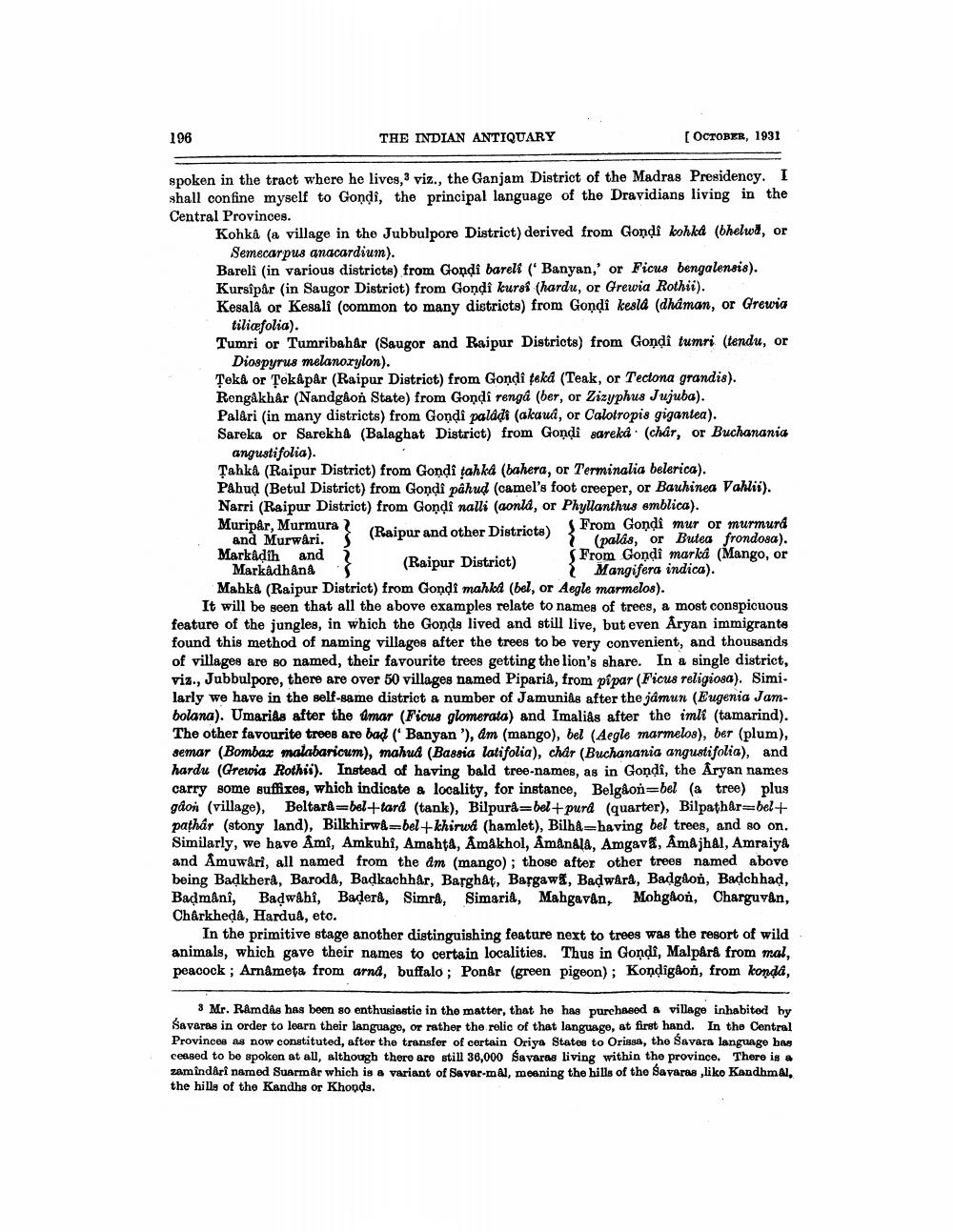________________
196
THE INDIAN ANTIQUARY
OCTOBER, 1931
spoken in the tract where he lives, viz., the Ganjam District of the Madras Presidency. I shall confine myself to Gondi, the principal language of the Dravidians living in the Central Provinces.
Kohka (a village in the Jubbulpore District) derived from Gondi kohka (bhelwa, or
Semecarpus anacardium). Bareli (in various districts) from Gondi bareli (* Banyan,' or Ficus bengalensis). Kursipar (in Saugor District) from Gondi kursi (hardu, or Grewia Rothii). Kesala or Kesali (common to many districts) from Gondi kesla (dhaman, or Grewia
tiliæfolia). Tumri or Tumribahar (Saugor and Raipur Districts) from Gondi tumri (tendu, or
Diospyrus melanoxylon). Tekâ or Tekapar (Raipur District) from Gondi teka (Teak, or Tectona grandis). Rongákhår (Nandgaon State) from Gondi renga (ber, or Zizyphus Jujuba). Palari (in many districts) from Gondi paladi (alaua, or Calotropis gigantea). Sareka or Sarekha (Balaghat District) from Gondi sarekd . (chár, or Buchanania
angustifolia). Tahka (Raipur District) from Gondi tahká (bahera, or Terminalia belerica). Pahud (Betul District) from Gondi pähud (camel's foot creeper, or Bauhinea Vahli). Narri (Raipur District) from Gondi nalli (aonld, or Phyllanthus emblica). Muripär, Murmura R and Murwari. (Raipur and other Districts) From Gondi mur or murmurd
(palás, or Butea frondosa). Markâdih and ? (Raipur District)
From Gondi marka (Mango, or
3 Mangifera indica). Mahka (Raipur District) from Gondi mahka (bel, or Aegle marmelos).
It will be seen that all the above examples relate to names of trees, a most conspicuous feature of the jungles, in which the Gonds lived and still live, but even Aryan immigrante found this method of naming villages after the trees to be very convenient, and thousands of villages are so named, their favourite trees getting the lion's share. In a single district, viz., Jubbulpore, there are over 50 villages named Piparia, from pipar (Ficus religiosa). Simi. larly we have in the self-same district a number of Jamunids after the jámun (Eugenia Jambolana). Umarids after the umar (Ficus glomerata) and Imaliâs after the imli (tamarind). The other favourite trees are bad (Banyan '), am (mango), bel (Aegle marmelos), bet (plum), semar (Bombax malabaricum), mahud (Bassia latifolia), char (Buchanania angustifolia), and hardu (Grewia Rothii). Instead of having bald tree-names, as in Gondi, the Aryan names carry some suffixes, which indicate a locality, for instance, Belgaon=bel (a tree) plus gdon (village), Beltari-bol+tard (tank), Bilpurd=bel+purd (quarter), Bilpath&r=bel + pathar (stony land), Bilkhirw=bel+khirwd (hamlet), Bilh&=having bel trees, and so on. Similarly, we have Ami, Amkuhi, Amahta, Amákhol, Amanala, Amgavā, Amajhal, Amraiya and Amuwari, all named from the am (mango); those after other trees named above being Badkhera, Baroda, Badkachhår, Barghát, Bargaw&, Badwårå, Badgaon, Badchhad, Badmâni, Badwabi, Badera, Simra, Simaria, Mahgavan, Mohgaon, Charguyên, Chårkhedá, Hardua, etc.
In the primitive stage another distinguishing feature next to trees was the resort of wild animals, which gave their names to certain localities. Thus in Gondi, Malpårå from mal, peacock ; Arnâmeta from arnd, buffalo; Ponår (green pigeon); Kondig&or, from konda,
3 Mr. Ramdas has been so enthusiastic in the matter, that he has purchased a village inhabited by Savaras in order to learn their language, or rather the relic of that language, at first hand. In the Central Provinces as now constituted, after the transfer of certain Oriya State to Orissa, the Savara language bag ceased to be spoken at all, although there are still 36,000 Savaras living within the province. There is a zamindari named Suarmar which is a variant of Savar-mal, meaning the hills of the Savaras ,like Kandhmal, the hills of the Kandhs or Khonds.




